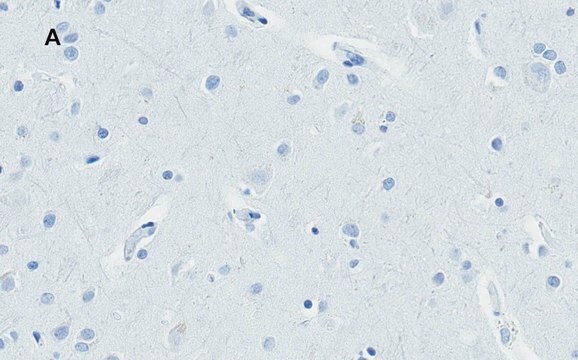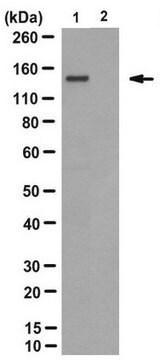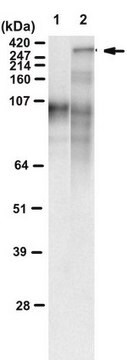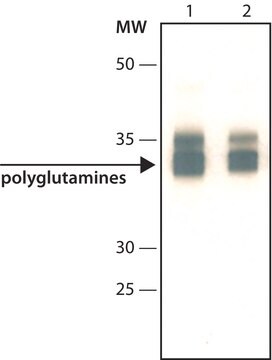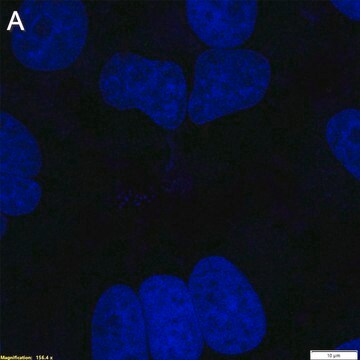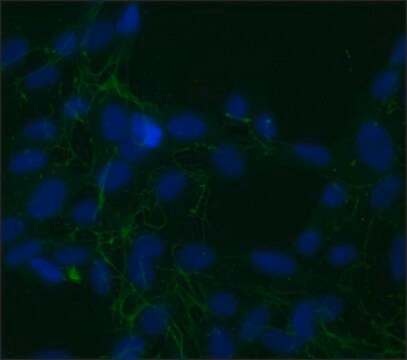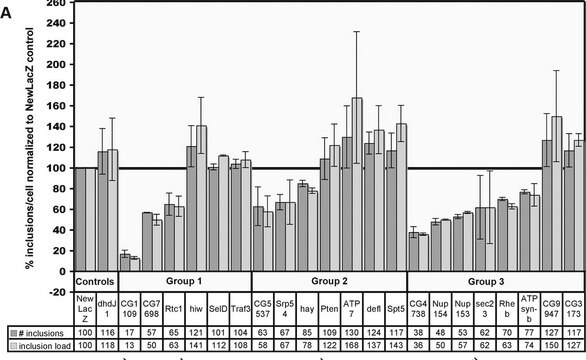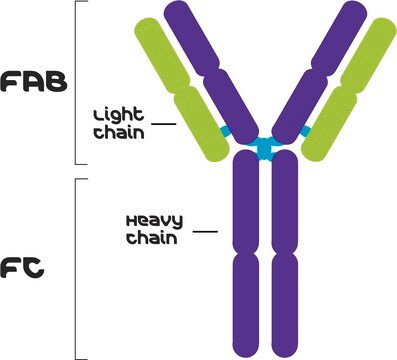MAB2166
Anti-Huntingtin Disease (HD/HTT) Antibody
CHEMICON®, mouse monoclonal, 1HU-4C8
Synonim(y):
Huntingtin, Huntington′s Disease Protein, HD Protein
About This Item
Polecane produkty
Nazwa produktu
Anti-Huntingtin Protein Antibody, a.a. 181-810, clone 1HU-4C8, ascites fluid, clone 1HU-4C8, Chemicon®
pochodzenie biologiczne
mouse
Poziom jakości
forma przeciwciała
ascites fluid
rodzaj przeciwciała
primary antibodies
klon
1HU-4C8, monoclonal
reaktywność gatunkowa
rat, rabbit
reaktywność gatunkowa (przewidywana na podstawie homologii)
mouse, human, hamster, monkey
producent / nazwa handlowa
Chemicon®
metody
ELISA: suitable
immunocytochemistry: suitable
immunohistochemistry: suitable (paraffin)
immunoprecipitation (IP): suitable
western blot: suitable
izotyp
IgG1κ
numer dostępu NCBI
numer dostępu UniProt
Warunki transportu
dry ice
docelowa modyfikacja potranslacyjna
unmodified
informacje o genach
human ... HTT(3064) , SLC6A4(6532)
Opis ogólny
Specyficzność
Immunogen
Zastosowanie
A 1:500-1:5,000 dilution of a previous lot was used on ELISA.
Immunohistochemistry:
A 1:500-1:5,000 dilution from a previous lot was used on frozen and microwave oven treated paraffin sections (human tissue).
Immunocytochemistry:
1:500-1:5,000 on a previous lot was used on transfected cells.
Immunoprecipitation:
A 1:500-1:5,000 dilution of a previous lot was used on immunoprecipitation.
Western blot:
1:500-1:5,000. Should detect a band migrating at approximately 350-400 kDa by Western blot (Nature Genetics 10:104-110.).
Optimal working dilutions must be determined by the end user.
Neuroscience
Neurodegenerative Diseases
Jakość
Western Blot Analysis:
1:1000 dilution of this lot detected huntingtin protein on 10 μg of rat brain lysates.
Opis wartości docelowych
Postać fizyczna
Przechowywanie i stabilność
Handling Recommendations: Upon receipt, and prior to removing the cap, centrifuge the vial and gently mix the solution. Aliquot into microcentrifuge tubes and store at -20°C. Avoid repeated freeze/thaw cycles, which may damage IgG and affect product performance.
Komentarz do analizy
Normal human cerebral cortex lysate
Inne uwagi
Informacje prawne
Oświadczenie o zrzeczeniu się odpowiedzialności
Nie możesz znaleźć właściwego produktu?
Wypróbuj nasz Narzędzie selektora produktów.
polecane
Kod klasy składowania
12 - Non Combustible Liquids
Klasa zagrożenia wodnego (WGK)
WGK 2
Temperatura zapłonu (°F)
Not applicable
Temperatura zapłonu (°C)
Not applicable
Certyfikaty analizy (CoA)
Poszukaj Certyfikaty analizy (CoA), wpisując numer partii/serii produktów. Numery serii i partii można znaleźć na etykiecie produktu po słowach „seria” lub „partia”.
Masz już ten produkt?
Dokumenty związane z niedawno zakupionymi produktami zostały zamieszczone w Bibliotece dokumentów.
Klienci oglądali również te produkty
Produkty
Immunofluorescencja wykorzystuje cząsteczki fluorescencyjne sprzężone z przeciwciałami do lokalizacji białek, potwierdzania modyfikacji i wizualizacji kompleksów białkowych.
Nasz zespół naukowców ma doświadczenie we wszystkich obszarach badań, w tym w naukach przyrodniczych, materiałoznawstwie, syntezie chemicznej, chromatografii, analityce i wielu innych dziedzinach.
Skontaktuj się z zespołem ds. pomocy technicznej